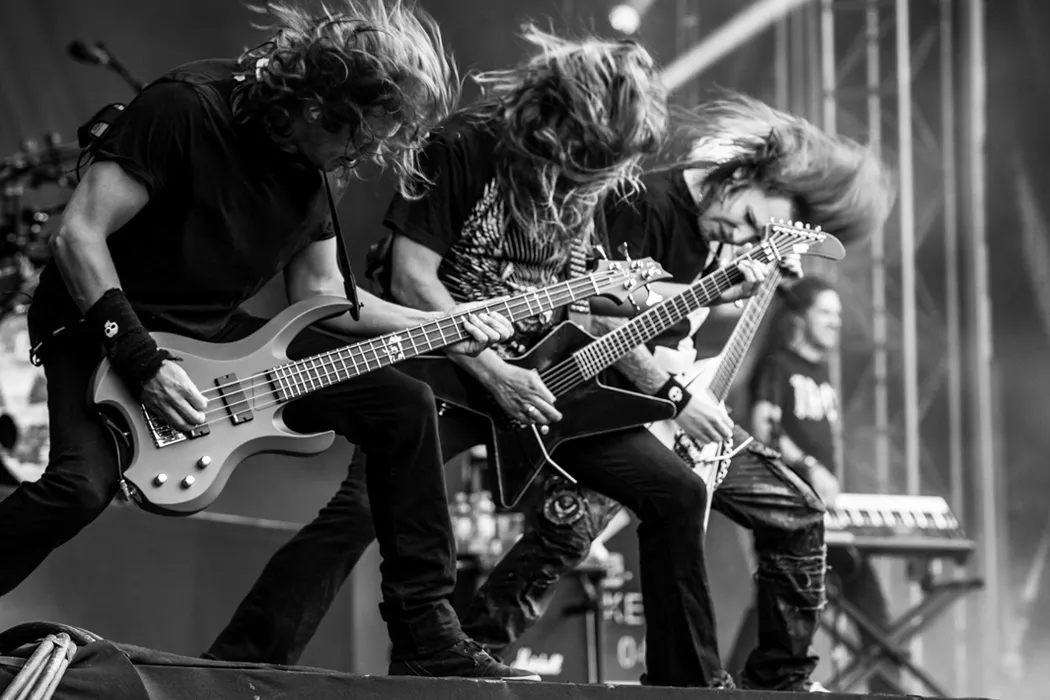In the vast landscape of music genres, the 1980s marked a period of significant transformation, with one genre in particular standing out as a rebellious force that reshaped the sonic landscape forever—thrash metal. Born from the intensity of punk rock and the technical prowess of heavy metal, 80’s thrash metal emerged as a powerful and groundbreaking force that would influence generations of musicians. In this article, we delve into the origins, key players, defining characteristics, and lasting impact of this genre that shook the foundations of the music industry.
Genesis of a Revolution
Thrash metal found its roots in the aggressive energy of punk and the intricate guitar work of traditional heavy metal. As the 1970s gave way to the 1980s, bands like Metallica, Slayer, Megadeth, and Anthrax began to take shape in the underground music scenes of Los Angeles, San Francisco, and New York. These bands shared a common vision—to push the boundaries of conventional metal by injecting speed, aggression, and socio-political commentary into their music.
The Big Four: Icons of 80’s Thrash Metal
Undoubtedly, the term “Big Four” in thrash metal refers to Metallica, Slayer, Megadeth, and Anthrax. These four bands not only defined the genre but also elevated it to a global phenomenon. Each brought a unique flavor to the thrash metal table, contributing to the diversity and richness that characterized the movement.
Metallica: Hailing from Los Angeles, Metallica quickly became the face of thrash metal with their groundbreaking debut album, “Kill ‘Em All” (1983). James Hetfield’s aggressive rhythm guitar paired with Kirk Hammett’s blistering solos set a new standard for speed and precision in metal.
Slayer: Known for their dark and aggressive approach, Slayer emerged from the streets of Huntington Park, California. Their album “Reign in Blood” (1986) is often hailed as one of the greatest thrash metal albums, featuring relentless speed, intricate guitar work, and lyrical themes exploring the macabre.
Megadeth: Founded by former Metallica guitarist Dave Mustaine, Megadeth brought a technical and virtuosic edge to thrash metal. Albums like “Peace Sells… but Who’s Buying?” (1986) showcased Mustaine’s sharp songwriting and guitar skills, solidifying Megadeth as a force to be reckoned with.
Anthrax: Hailing from New York City, Anthrax blended thrash metal with elements of hardcore punk. Known for their energetic live performances, Anthrax’s “Among the Living” (1987) is a thrash metal classic, featuring infectious riffs and socially conscious lyrics.
Defining Characteristics of 80’s Thrash Metal
Thrash metal distinguished itself from other metal subgenres through a combination of distinctive musical elements and rebellious attitudes. The following characteristics became the hallmarks of 80’s thrash metal:
Speed and Aggression: Thrash metal’s defining trait was its breakneck speed, often achieved through rapid guitar riffs, double-bass drumming, and frenetic solos. This aggressive pace set it apart from the more measured tempo of traditional heavy metal.
Complex Guitar Work: Thrash metal guitarists showcased technical proficiency with intricate riffs, fast picking, and blistering solos. The genre’s guitarists became revered for their ability to seamlessly blend melody with sheer sonic force.
Social and Political Commentary: Unlike some of their heavy metal predecessors, thrash metal bands embraced lyrics that addressed socio-political issues. From war and corruption to personal struggles, thrash metal lyrics were unapologetically raw and confrontational.
DIY Mentality: Thrash metal emerged from underground scenes, and many bands adhered to a DIY (Do It Yourself) ethos. They recorded and distributed their music independently, creating a direct connection with their fanbase and bypassing traditional music industry gatekeepers.
Legacy and Influence
The impact of 80’s thrash metal extended far beyond the decade of its origin. The genre laid the groundwork for numerous subgenres and influenced a diverse range of bands across the musical spectrum. Here are some key areas where thrash metal’s legacy endures:
Extreme Metal Genres: Thrash metal paved the way for the development of various extreme metal subgenres, including death metal, black metal, and groove metal. Bands within these genres often cite thrash metal as a primary influence, acknowledging its role in shaping the sonic brutality of their own music.
Cross-Genre Collaborations: The influence of thrash metal can be heard in unexpected places, as artists from diverse genres experiment with its aggressive energy. Crossovers between thrash metal and punk, hip-hop, or electronic music showcase the genre’s adaptability and enduring appeal.
Global Impact: Thrash metal’s impact was not limited to the United States. Bands from Germany, Brazil, and the United Kingdom, among others, embraced the thrash metal ethos and developed their own vibrant scenes. This global proliferation ensured that thrash metal became a truly international phenomenon.
Enduring Fanbase: The fanbase cultivated during the 80s has remained loyal and dedicated. Thrash metal concerts and festivals continue to draw large crowds, with both classic acts and newer bands carrying the torch forward.
Conclusion
As we reflect on the 80’s thrash metal movement, it’s evident that this genre was more than just a musical style; it was a cultural force that challenged conventions and set the stage for the evolution of heavy music. The Big Four, along with countless other thrash metal bands, reshaped the landscape of metal and influenced generations of musicians who followed in their footsteps. The rebellious spirit, technical prowess, and unapologetic attitude of 80’s thrash metal continue to resonate, ensuring its place as a timeless and influential chapter in the history of music.

